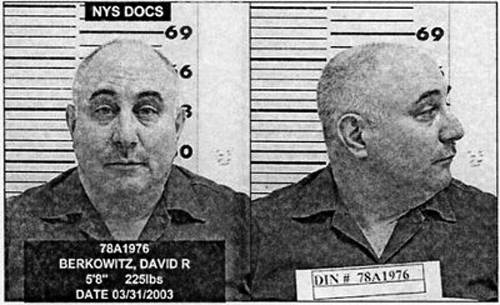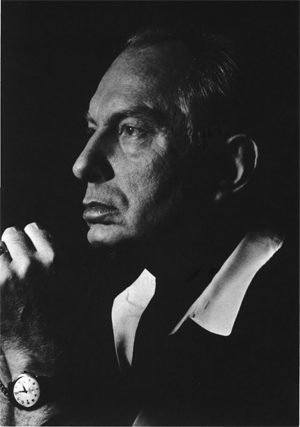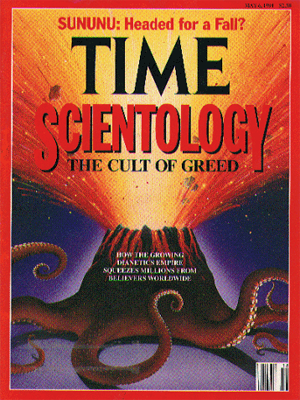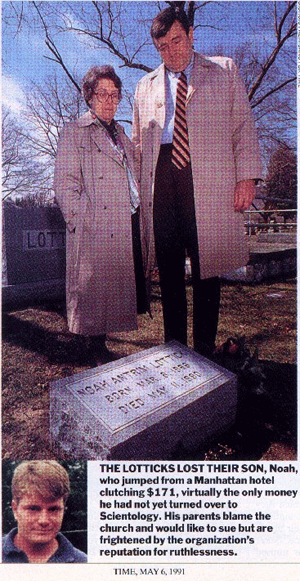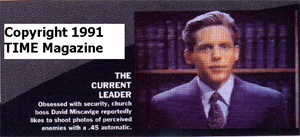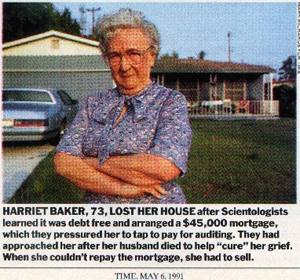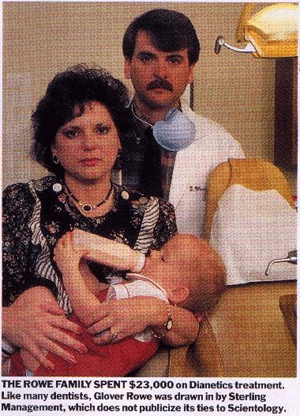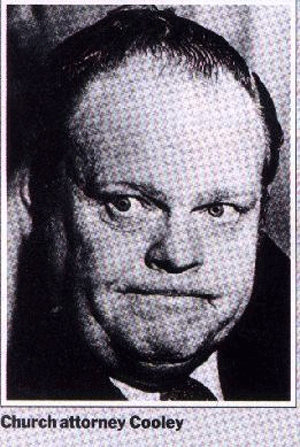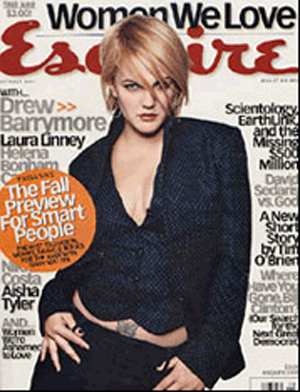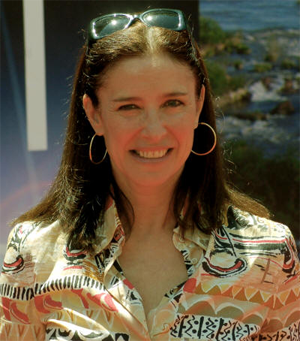Re: Journalism: Scientology - L. Ron Hubbard's Brainchild
The Life and Death of a Scientologist: 13 Years and Thousands Of Dollars, Lisa McPherson Finally Went 'Clear.' Then She Went Insane.
by Richard Leiby
Washington Post Staff Writer
Sunday, December 6, 1998; Page F01
CLEARWATER, Fla. - Dec 6, 1998 - "I am L. Ron Hubbard," the woman on the hotel room bed announced in a robotic voice. "I created time 3 billion years ago." She rambled on and on, every outburst dutifully scribbled down by those assigned to watch her.
"I can't confront force ... I need my auditor ... I want to take a toothbrush and brush the floor until I have a cognition."
The jargon of Scientology was instantly familiar to anyone who entered the room in the Fort Harrison Hotel, part of an elite training center and retreat established here by Hubbard, the science fiction writer and self-styled religious leader. It was also obvious to her fellow Scientologists that Lisa McPherson had cracked up.
"Out of control," one wrote.
Beginning Nov. 18, 1995, Scientology staffers -- following Hubbard's regimen for dealing with psychotic members -- kept McPherson isolated in that room 24 hours a day, refusing to speak to her, trying to force-feed her, plying her with vitamins and herbal concoctions and injecting her with sedatives, according to several accounts that are now part of court records. She furiously resisted: She pounded the walls, tried to escape, attacked a staffer with a potted plant. In her delirium, records say, she defecated on herself and drank her own urine.
Within 17 days, McPherson -- who'd spent most of her adult life and tens of thousands of dollars as a devotee of Hubbard's teachings -- would be dead. The once-voluptuous 36-year-old -- she stood 5 feet 9 and wore a size 12 dress -- lost an estimated 40 to 50 pounds during the ordeal, dropping to 108, her bruised body pocked by insect bites and scabs.
She was never seen by a licensed physician during that time. An autopsy attributed her death to a blood clot that developed due to "severe dehydration" and "bed rest."
Last month, after more than two years of investigation, the state attorney here filed two felony counts against the Scientology organization, alleging abuse or neglect of a disabled adult and the practice of medicine without a license. (No individuals were charged; to obtain their testimony, all Scientology witnesses were given immunity by prosecutors.) A criminal conviction would only bring fines of up to $15,000, but also would allow a court to order restitution to the victim's family and payment of law enforcement investigation costs.
The church has pleaded not guilty. Mike Rinder, senior spokesman for Scientology, would not respond to any questions about McPherson, but issued a statement calling the "circumstances" of her death "unfortunate," and contending that the church had no "intent to do any harm" to its devotee.
Church lawyers would not comment.
Meanwhile, McPherson's aunt has filed a wrongful death suit against the church, saying McPherson suffered "extreme torture" as "a prisoner of Scientology."
Church officials have said they were honoring McPherson's religious preferences; Scientology vehemently denounces all forms of psychotherapy.
This weekend, to mark the anniversary of McPherson's death, Scientology defectors and other activists picketed near the Fort Harrison Hotel. Since its founding 45 years ago, the Church of Scientology has endured more than its share of bad publicity, but the McPherson case puts on stark display a side of the religion far removed from the glowing testimonials it receives from Hollywood adherents like John Travolta, Tom Cruise and Isaac Hayes.
If, as Hubbard decreed, the ultimate aim of Scientology is its adherents' "total freedom" and "survival," then what went wrong in the case of Lisa McPherson?
"At last, here is a book ... which provides the answers to the problems of the human mind," pledged Hubbard's 1950 bestseller, "Dianetics: The Modern Science of Mental Health." It was the cornerstone of the religion he later founded. Once "cleared" of their troublesome brain "engrams," followers would be happy and healthier, have higher IQs and become "stable mentally," Hubbard believed.
In September 1995, Lisa McPherson proudly attested to reaching the state of "clear" at a Scientology ceremony. Within a few weeks, her mind began to unravel. After 13 years of intensive study, she was still failing as a Scientologist; indeed, she had become one of the worst kinds of problems -- in church lingo, a "Potential Trouble Source Type III," or what Hubbard also called an "insane being."
Out in the real world, around non-Scientologists, McPherson was dramatically breaking down, becoming a public embarrassment. Scientologists weren't supposed to do that.
The Founder, a flame-haired, swashbuckling figure, died in 1986, but his every utterance and writing is viewed by Scientologists as consecrated, immutable scripture. Hubbard seemed to take a dim view of those who suffered breakdowns.
"We have nothing to do with the insane whatsoever. The insane, well, they're insane!" he once declared in a rare television interview. Little could be done for psychotics. "Provide a relatively safe environment and quiet and rest and no treatment of a mental nature at all," he wrote in a 1965 policy letter.
"There will always be some failures," he continued, and "sometimes [they] can't be kept alive."
McPherson grew up in Dallas, the daughter of an insurance man and his homemaker wife, attending Baptist churches. She had an older brother she loved, named Steve.
When Steve was 16 he shot himself in the head in a gas station rest room. Lisa was 14. The suicide was apparently connected to a dispute with another teen, although the details remain vague to Lisa's aunt and closest living relative, Dell Liebreich. But Liebreich knows one thing: "I'm sure it had a traumatizing effect on Lisa. Her father never recovered from it. He committed suicide 10 years later." He too used a pistol.
After high school, McPherson went to work at Southwestern Bell, where her family says a supervisor recruited her into Scientology. A vivacious brown-eyed blonde, fond of frosting her hair, McPherson had an early, troubled marriage that lasted only a few years. But she did well at the phone company, and she avidly studied Hubbard's techniques. "She was always going to the mission, taking courses," recalls Liebreich, who signed on to the lawsuit against Scientology after Lisa's mother, Fannie, died last year.
The church's account of McPherson's tenure has required criminal investigators and civil case lawyers to learn another language -- Hubbard-speak. For example, a Scientology-prepared report on McPherson says that in "Dec. 86/Jan. 87 she had a PTS Rundown (items were Mom, Don and Theresa)... . This was followed by a large amount of wordclearing, False Data Stripping and O/W write ups."
Translation:
In confessional rituals, a parishioner must declare his O/Ws -- "overts and withholds" -- immoral acts that include harmful, undisclosed transgressions against Scientology. Any miscomprehensions about anything -- including the church and its teachings -- are "false data" that must be stripped away.
In Hubbard's cosmology, traumas in past lifetimes, contact with alien beings, drug use and involvement with "suppressive persons" (who include enemies of the church) all can be impediments to a "pre-clear's" success. They must be located and removed by "auditing."
According to the church, McPherson took her first courses in 1982, when she was 23, and tried but failed to go "clear" in 1986. She took a staff job and married a member of the church. In 1989, she also committed herself to serving Scientology for a "billion years," signing up for its Sea Organization, an elite group whose members wear nautical uniforms and follow a militaristic command structure, working long hours for salaries of $50 a week.
A World War II Navy lieutenant, Hubbard ran his sect for several years from aboard a 320-foot converted cattle ferry, sailing the world before establishing what he called the Flag Land Base at Clearwater, a placid town of white sand beaches on the Gulf of Mexico. The Commodore, as Hubbard was known, lived nearby briefly in the mid-1970s. He told aides he planned to pose as a photographer in the tourist industry.
Today, about 6,000 Scientology followers and staffers live in the Clearwater area -- many based at the campus of former hotels where Hubbard's "religious technology" is offered at the most advanced (and expensive) levels. Several Scientologist-operated businesses also maintain headquarters here.
McPherson migrated to Clearwater in the early '90s after her new Scientology employers relocated their publishing firm here. She'd divorced again, and had left the Sea Organization. But she kept attempting to reach "clear." Records show she was thwarted again in 1991 and 1994 because she was a "potential trouble source" -- the E-meter sessions revealed she'd been in contact with suppressive, anti-Scientology elements.
At first McPherson flourished as a sales rep at AMC Publishing; she made $136,721 in 1994, according to her tax returns, spending more than $55,000 on Scientology courses and taking deductions for them. (The IRS, after fighting hundreds of lawsuits filed by Scientology, granted the church tax-exempt status in 1993.)
Then, turmoil. "In June 1995, Lisa caved in and actually went into a spin (psychotic break)," says the church report. This forced a brief recuperation at the Fort Harrison Hotel and a slowdown in her work. She was put into "ethics handling" -- a regimen that includes writing up "overts and withholds."
Her aunt, an old high school friend and others believe McPherson was on the verge of quitting the church -- and that was her undisclosed crime against Scientology.
"She was roller-coastering: up and down, up and down, high emotions and low emotions," says Michael Pattinson, a painter and recent Scientology defector who got to know McPherson in the months before her death. "She wanted to do something more artistic in her life, and the group's power and pressure were too much for her.
"She was having a very, very rough time at work keeping up with the quotas for sales," Pattinson recalls. "She asked for my advice. I said, 'Lisa, follow your own goals, not someone else's, or you'll end up in the soup.'"
Scientology officials say McPherson was a devoted member. And on Sept. 7, she finally reached her cherished goal: "I'm from Texas and I'm Clear!" she announced to a roomful of fellow members, reading from a script now in court files.
"Being Clear is more exciting than anything I've ever experienced. I am so thrilled about life and living that I can hardly stand it!"
McPherson's final hurdle to Clear was an incident from a past life. A saber-toothed tiger kept attacking and eating her: "Not only did I see him, I was in a cage with him for six months."
Auditing "handled" that problem, McPherson told her audience. But other problems arose.
By mid-October, church records show that officials had declared her a "liability" to Scientology, apparently after her production dropped off at her publishing job. In Hubbard's jargon, that meant McPherson had "taken on the color of an enemy" and could not be trusted. In a memo, she said she was making "amends," and working seven days a week, from 7 a.m. to 10:30 p.m., in part to raise money for the church's "Winter Wonderland" holiday event.
By November, she began to act out in bizarre ways: At a business conference in Orlando, she insisted to strangers that they had to read L. Ron Hubbard's "Dianetics." She interrogated a co-worker about "suppressive people." She rousted the colleague in the middle of the night, raving about "something going on on this planet that I didn't know about."
"When I woke up at 7 a.m. I found her still in the bathroom reading" Hubbard's works, the woman wrote in a report to church officials. "She looked like hell."
One year ago, on the sidewalk in front of the Fort Harrison Hotel, Scientology critics lit candles in a memorial to McPherson. Their signs bore her grisly autopsy photos. Their T-shirts said "Scientology Kills."
A few blocks away in a counterdemonstration, thousands of church members staged a "civil rights" march on the Clearwater Police Department and the local office of the St. Petersburg Times, charging that police and media investigations of the McPherson case amounted to a hate campaign.
For many residents, the long-running McPherson case has revived unwelcome memories of Scientology's controversial past here -- in the mid-'70s the town's political, business and media establishment were targeted for what Hubbard memos termed "takeover" and "control." In 1975, Hubbard moved his sect ashore, secretly purchasing downtown properties under the guise of a group called United Churches of Florida.
The guru's plan to create a Scientology-run city -- part of an even more grandiose scheme for global domination -- foundered after FBI raids and news reports exposed his goals. Prosecutors used internal church documents to help convict Hubbard's wife and 10 other top Scientologists in a conspiracy to infiltrate, bug and burglarize federal agencies. Hubbard was named an unindicted co-conspirator in that case.
Scientology leaders, who say they purged the church of criminals 15 years ago, claim it enjoys excellent relations with the city. Last month, ground was broken for a $45 million Scientology center in the faded downtown; at 370,000 square feet, it's the largest construction project in the church's history.
Only a few bigots and "rednecks" oppose its presence here, church officials say.
"The sun never sets on Scientology," church leader David Miscavige, quoting Hubbard, said at the glitzy groundbreaking, which included a laser light show.
"Scientology now, tomorrow and forever."
The dueling demonstrations over the McPherson case coincided with the opening of "Winter Wonderland," an annual holiday display erected by the church to collect food and toys for the poor. Rocker Edgar Winter, a Scientologist, welcomed the crowd and praised "this wonderful gift to the community."
Bennetta Slaughter, owner of AMC Publishing and a Scientologist for nearly 20 years, spoke of the church's dedication to children. She pointed out that a $3,400 donation by her deceased employee, Lisa McPherson, helped make it all possible.
"She was one of my very good friends and I loved her very much," Slaughter said later, bracing against the breeze in a Christmas sweater and red velvet skirt.
"It's a farce that they're demonstrating [against the church]. They're desecrating her memory, not honoring her memory."
Slaughter and her company were initially named as defendants in McPherson's aunt's suit, but were later dropped from the action. "I absolutely know that what occurred with Lisa -- " Slaughter began. She paused. "She was not denied anything. The things that have been said are complete misrepresentations on the part of those who would attack the church. They're falsehoods."
And why would people criticize her church?
"No data," she quickly replied. "Obviously there's an agenda."
From the very beginning, the therapies of L. Ron Hubbard have been denounced by medical authorities as quackery, hypnotism and brainwashing. One of the first judicial investigations of Scientology, conducted in Australia in the 1960s, deemed the auditing process a form of "mental torture" and resulted in a ban on Scientology practices.
(By 1982, Australia overturned its ban and recognized Scientology as a religion. But an official commission of top legal experts recently recommended that significant psychological harm inflicted by any religious group, including Scientology, be made a crime.)
In 1978, a French court tried Hubbard in absentia for fraud and sentenced him to four years' imprisonment.
In 1986, a California jury awarded $30 million to a former Sea Organization member who said the church's advanced regimens caused him to become psychotic and actively plan suicide. (The award, later reduced to $2.5 million, has been upheld by the Supreme Court, but the former member has yet to collect because of exhaustive litigation by the church.)
In a 1984 decision, Los Angeles Superior Court Judge Paul G. Breckenridge said Scientology "is nothing in reality but a vast enterprise to extract the maximum amount of money from its adepts by pseudo-scientific theories ... and to exercise a kind of blackmail against persons who do not wish to continue with their sect.... The organization clearly is schizophrenic and paranoid, and this bizarre combination seems to be a reflection of its founder."
Such conclusions strike especially close to the heart of Scientology, a belief system whose strongest rhetoric is reserved for its criticism of psychiatry.
Hubbard said he wanted to control "absolutely the field of mental healing on this planet in all forms." He denounced shrinks as crackpots and butchers who killed patients' souls with electroshock therapy and drugs.
But there may have been a deeper source of the Founder's ire. His eldest son, L. Ron Hubbard Jr., once swore an affidavit saying his father "ended up in psychiatric hospital at the end of the war." (Hubbard Jr. is dead; the church says the Founder never received treatment and that the son recanted his criticism.)
In a letter written to the Veterans Administration in 1947, Hubbard senior admitted to suicidal tendencies and asked for psychiatric help.
Denouncing doctors, Hubbard claimed his research revealed the true nature of the mind. "All of these things are scientific facts, tested and rechecked and tested again," he wrote in "Dianetics." But his son said the findings -- initially published in the pulp magazine Astounding Science Fiction -- was without scientific merit: "My father wrote his books off the top of his head based on his imagination. There were no case studies."
"He audited me and it didn't help," says Richard de Mille, a Dianetics believer from 1950 to 1953. "I came to understand that it was all his imagination, just a story he was telling."
De Mille, 76, son of the famous director, says Hubbard transformed his self-help discoveries into a religion to avoid having to prove them: "It became a religion very suddenly and all his magical ideas jumped back into it."
The apex of Scientology spiritual counseling is at the secret, so-called OT Levels, which promise superhuman powers. Here, members pass through what Hubbard described as the Wall of Fire. Parishioners -- who have already spent thousands to go clear -- pay several thousand more to learn that their spiritual traumas stem from an intergalactic holocaust perpetrated 75 million years ago by an alien overlord named Xenu.
During a space battle, Hubbard teaches, our spirits became infested with evil alien spirits, called "body thetans." There could be untold numbers of such bad thetans fomenting problems in each of our minds. Only through rigorous auditing can they be removed -- allowing the untormented Operating Thetan -- the OT -- to emerge.
In 1995, church financial records show, McPherson paid nearly $42,000 in "donations" for top-level courses -- including "Wall of Fire," the "Flag OT Executive Rundown" and "OT Preparations and Eligibility."
On Nov. 10, 1995, court records show, the devotee purchased her last religious item from the Church of Scientology. It was a 1996 calendar featuring L. Ron Hubbard. Price: $100.
"No one told me I was a prisoner, but I knew that I wouldn't just walk out the door.... It's embedded over the years that, once you're a Scientologist, there's nowhere to go; you just don't leave." -- Former church staff member Lori Taverna, testifying to the Clearwater City Commission in 1982.
After a minor traffic accident, McPherson stripped off her clothes and walked naked down well-traveled Belleview Boulevard. She told stunned paramedics she wasn't crazy but just wanted to get their attention: "I need help. I need to talk to someone." She spoke in a monotone, as if programmed, and said she didn't need a body to live.
"I'm an OT," she said. An Operating Thetan.
It was shortly after 6 p.m. on Nov. 18, 1995. McPherson had driven her '93 Jeep Cherokee into a boat being towed on a trailer. She wasn't hurt.
The paramedics took her to nearby Morton Plant Hospital. Nurses there said she looked calm, but they noticed her fixed stare. McPherson disclosed that her brother and father had committed suicide, but denied she wanted to kill herself or anyone else.
By 6:50, a group of Scientologists had arrived. By the church's account, McPherson had phoned her friend and boss, Bennetta Slaughter. (Hospital records contain no mention of McPherson making any calls.) The Scientologists explained that a psychiatric consultation would violate McPherson's religion.
At 7:30, a psychiatric nurse went to McPherson's bedside, where she was surrounded by church members. Again she spoke in that monotone, telling the nurse, "I want to go home with my friends from the congregation."
An emergency room doctor decided, after talking by phone with a psychiatrist, that the patient could not be involuntarily committed. "Her friends at scientology will watch her 24 hours and be sure that she gets the care that they want her to have and the patient wants to have," the doctor typed in his report. But he seemed uneasy, adding: "I told her I could not be responsible ... I will have the patient sign out against medical advice."
Around 8:30, she was taken to the Fort Harrison Hotel and put in Room 174. She would not leave again until the night of Dec. 5.
Scientologists loaded McPherson's nearly lifeless body into a church van.
Instead of calling an ambulance or driving her to Morton Plant, five minutes away, she was taken 45 minutes north to Columbia/HCA New Port Richey Hospital.
Her watchers had decided it would be best if McPherson were treated by a Scientology doctor -- an OT-course graduate named David Minkoff who worked in the emergency room at the New Port Richey hospital. Minkoff had earlier prescribed Valium for McPherson without seeing her, according to a Florida Department of Law Enforcement affidavit. (Minkoff, initially named in the wrongful death suit, authorized his insurers to settle with McPherson's estate for $100,000 -- what his attorney called a "pittance in comparison with the millions and millions they were asking for.")
McPherson never got the Valium. Staffers told investigators that they feared any drug might interfere with her future auditing. So instead they loaded aspirin and Benadryl into a syringe and forced it down her throat. McPherson's "case supervisor" believed the aspirin "might assist in blocking Lisa's formation of mental images," the prosecution affidavit says.
Through the 17 days since her naked stroll down Belleview Boulevard, McPherson had been attended by Janis Johnson, an unlicensed anesthesiologist who served as the Flag base medical liaison officer, by a dentist and by staffers with no medical training, including a 17-year-old. One woman assigned to McPherson's room broke down, sat in a corner and cried, records show.
The Scientologists injected McPherson with magnesium chloride and gave her the sedative chloral hydrate -- both substances apparently endorsed by Hubbard. By Dec. 1, she was so dehydrated that she needed two liters of fluid, according to Johnson's notes. The medical examiner later said it appeared that she'd gone without water for at least five days. The watchers' records are spotty, and church logs of her final 53 hours were lost or destroyed, according to the prosecution affidavit.
A reconstruction of events that Scientology turned over to lawyers for McPherson's estate, as well as prosecutors' findings, describe McPherson's final day:
By Dec. 5, she couldn't walk. She'd been lapsing in and out of consciousness, barely moving. That morning, Johnson thought McPherson looked "septic," as if suffering from a massive infection. Around 7 p.m., Johnson called Minkoff, requesting he issue a prescription for penicillin.
Minkoff says he refused and advised that the patient be taken to the nearest hospital. But Johnson said, "Lisa was not that sick." She would transport McPherson 24 miles to New Port Richey instead.
McPherson's breathing grew heavy and labored on the trip. She was loaded into a wheelchair when they reached the hospital around 9:30. Minkoff said he was shocked by her "horrific" appearance.
He pronounced her dead on arrival.
According to the charging document, "This inexcusable delay in seeking emergency help ... deprived Lisa of her only opportunity for survival."
A Scientology report on the incident begins this way: "Lisa McPherson, Flag public living in Clearwater, FL., dropped her body this evening while being taken to a hospital."
On Aug. 6, 1996, eight months after she died, the church mailed Lisa McPherson a statement showing a credit of $3,000. Her next course, called "OT Debug Service," was paid for and waiting.
© Copyright 1998 The Washington Post Company
by Richard Leiby
Washington Post Staff Writer
Sunday, December 6, 1998; Page F01
CLEARWATER, Fla. - Dec 6, 1998 - "I am L. Ron Hubbard," the woman on the hotel room bed announced in a robotic voice. "I created time 3 billion years ago." She rambled on and on, every outburst dutifully scribbled down by those assigned to watch her.
"I can't confront force ... I need my auditor ... I want to take a toothbrush and brush the floor until I have a cognition."
The jargon of Scientology was instantly familiar to anyone who entered the room in the Fort Harrison Hotel, part of an elite training center and retreat established here by Hubbard, the science fiction writer and self-styled religious leader. It was also obvious to her fellow Scientologists that Lisa McPherson had cracked up.
"Out of control," one wrote.
Beginning Nov. 18, 1995, Scientology staffers -- following Hubbard's regimen for dealing with psychotic members -- kept McPherson isolated in that room 24 hours a day, refusing to speak to her, trying to force-feed her, plying her with vitamins and herbal concoctions and injecting her with sedatives, according to several accounts that are now part of court records. She furiously resisted: She pounded the walls, tried to escape, attacked a staffer with a potted plant. In her delirium, records say, she defecated on herself and drank her own urine.
Within 17 days, McPherson -- who'd spent most of her adult life and tens of thousands of dollars as a devotee of Hubbard's teachings -- would be dead. The once-voluptuous 36-year-old -- she stood 5 feet 9 and wore a size 12 dress -- lost an estimated 40 to 50 pounds during the ordeal, dropping to 108, her bruised body pocked by insect bites and scabs.
She was never seen by a licensed physician during that time. An autopsy attributed her death to a blood clot that developed due to "severe dehydration" and "bed rest."
Last month, after more than two years of investigation, the state attorney here filed two felony counts against the Scientology organization, alleging abuse or neglect of a disabled adult and the practice of medicine without a license. (No individuals were charged; to obtain their testimony, all Scientology witnesses were given immunity by prosecutors.) A criminal conviction would only bring fines of up to $15,000, but also would allow a court to order restitution to the victim's family and payment of law enforcement investigation costs.
The church has pleaded not guilty. Mike Rinder, senior spokesman for Scientology, would not respond to any questions about McPherson, but issued a statement calling the "circumstances" of her death "unfortunate," and contending that the church had no "intent to do any harm" to its devotee.
Church lawyers would not comment.
Meanwhile, McPherson's aunt has filed a wrongful death suit against the church, saying McPherson suffered "extreme torture" as "a prisoner of Scientology."
Church officials have said they were honoring McPherson's religious preferences; Scientology vehemently denounces all forms of psychotherapy.
This weekend, to mark the anniversary of McPherson's death, Scientology defectors and other activists picketed near the Fort Harrison Hotel. Since its founding 45 years ago, the Church of Scientology has endured more than its share of bad publicity, but the McPherson case puts on stark display a side of the religion far removed from the glowing testimonials it receives from Hollywood adherents like John Travolta, Tom Cruise and Isaac Hayes.
If, as Hubbard decreed, the ultimate aim of Scientology is its adherents' "total freedom" and "survival," then what went wrong in the case of Lisa McPherson?
"At last, here is a book ... which provides the answers to the problems of the human mind," pledged Hubbard's 1950 bestseller, "Dianetics: The Modern Science of Mental Health." It was the cornerstone of the religion he later founded. Once "cleared" of their troublesome brain "engrams," followers would be happy and healthier, have higher IQs and become "stable mentally," Hubbard believed.
In September 1995, Lisa McPherson proudly attested to reaching the state of "clear" at a Scientology ceremony. Within a few weeks, her mind began to unravel. After 13 years of intensive study, she was still failing as a Scientologist; indeed, she had become one of the worst kinds of problems -- in church lingo, a "Potential Trouble Source Type III," or what Hubbard also called an "insane being."
Out in the real world, around non-Scientologists, McPherson was dramatically breaking down, becoming a public embarrassment. Scientologists weren't supposed to do that.
The Founder, a flame-haired, swashbuckling figure, died in 1986, but his every utterance and writing is viewed by Scientologists as consecrated, immutable scripture. Hubbard seemed to take a dim view of those who suffered breakdowns.
"We have nothing to do with the insane whatsoever. The insane, well, they're insane!" he once declared in a rare television interview. Little could be done for psychotics. "Provide a relatively safe environment and quiet and rest and no treatment of a mental nature at all," he wrote in a 1965 policy letter.
"There will always be some failures," he continued, and "sometimes [they] can't be kept alive."
McPherson grew up in Dallas, the daughter of an insurance man and his homemaker wife, attending Baptist churches. She had an older brother she loved, named Steve.
When Steve was 16 he shot himself in the head in a gas station rest room. Lisa was 14. The suicide was apparently connected to a dispute with another teen, although the details remain vague to Lisa's aunt and closest living relative, Dell Liebreich. But Liebreich knows one thing: "I'm sure it had a traumatizing effect on Lisa. Her father never recovered from it. He committed suicide 10 years later." He too used a pistol.
After high school, McPherson went to work at Southwestern Bell, where her family says a supervisor recruited her into Scientology. A vivacious brown-eyed blonde, fond of frosting her hair, McPherson had an early, troubled marriage that lasted only a few years. But she did well at the phone company, and she avidly studied Hubbard's techniques. "She was always going to the mission, taking courses," recalls Liebreich, who signed on to the lawsuit against Scientology after Lisa's mother, Fannie, died last year.
The church's account of McPherson's tenure has required criminal investigators and civil case lawyers to learn another language -- Hubbard-speak. For example, a Scientology-prepared report on McPherson says that in "Dec. 86/Jan. 87 she had a PTS Rundown (items were Mom, Don and Theresa)... . This was followed by a large amount of wordclearing, False Data Stripping and O/W write ups."
Translation:
Using an E-meter, a lie detector-like device that Hubbard invented, a counselor discovered that McPherson was a "potential trouble source" in Scientology because of her connection to three "suppressive" people, including her mother.
In confessional rituals, a parishioner must declare his O/Ws -- "overts and withholds" -- immoral acts that include harmful, undisclosed transgressions against Scientology. Any miscomprehensions about anything -- including the church and its teachings -- are "false data" that must be stripped away.
In Hubbard's cosmology, traumas in past lifetimes, contact with alien beings, drug use and involvement with "suppressive persons" (who include enemies of the church) all can be impediments to a "pre-clear's" success. They must be located and removed by "auditing."
According to the church, McPherson took her first courses in 1982, when she was 23, and tried but failed to go "clear" in 1986. She took a staff job and married a member of the church. In 1989, she also committed herself to serving Scientology for a "billion years," signing up for its Sea Organization, an elite group whose members wear nautical uniforms and follow a militaristic command structure, working long hours for salaries of $50 a week.
A World War II Navy lieutenant, Hubbard ran his sect for several years from aboard a 320-foot converted cattle ferry, sailing the world before establishing what he called the Flag Land Base at Clearwater, a placid town of white sand beaches on the Gulf of Mexico. The Commodore, as Hubbard was known, lived nearby briefly in the mid-1970s. He told aides he planned to pose as a photographer in the tourist industry.
Today, about 6,000 Scientology followers and staffers live in the Clearwater area -- many based at the campus of former hotels where Hubbard's "religious technology" is offered at the most advanced (and expensive) levels. Several Scientologist-operated businesses also maintain headquarters here.
McPherson migrated to Clearwater in the early '90s after her new Scientology employers relocated their publishing firm here. She'd divorced again, and had left the Sea Organization. But she kept attempting to reach "clear." Records show she was thwarted again in 1991 and 1994 because she was a "potential trouble source" -- the E-meter sessions revealed she'd been in contact with suppressive, anti-Scientology elements.
At first McPherson flourished as a sales rep at AMC Publishing; she made $136,721 in 1994, according to her tax returns, spending more than $55,000 on Scientology courses and taking deductions for them. (The IRS, after fighting hundreds of lawsuits filed by Scientology, granted the church tax-exempt status in 1993.)
Then, turmoil. "In June 1995, Lisa caved in and actually went into a spin (psychotic break)," says the church report. This forced a brief recuperation at the Fort Harrison Hotel and a slowdown in her work. She was put into "ethics handling" -- a regimen that includes writing up "overts and withholds."
Her aunt, an old high school friend and others believe McPherson was on the verge of quitting the church -- and that was her undisclosed crime against Scientology.
"She was roller-coastering: up and down, up and down, high emotions and low emotions," says Michael Pattinson, a painter and recent Scientology defector who got to know McPherson in the months before her death. "She wanted to do something more artistic in her life, and the group's power and pressure were too much for her.
"She was having a very, very rough time at work keeping up with the quotas for sales," Pattinson recalls. "She asked for my advice. I said, 'Lisa, follow your own goals, not someone else's, or you'll end up in the soup.'"
Scientology officials say McPherson was a devoted member. And on Sept. 7, she finally reached her cherished goal: "I'm from Texas and I'm Clear!" she announced to a roomful of fellow members, reading from a script now in court files.
"Being Clear is more exciting than anything I've ever experienced. I am so thrilled about life and living that I can hardly stand it!"
McPherson's final hurdle to Clear was an incident from a past life. A saber-toothed tiger kept attacking and eating her: "Not only did I see him, I was in a cage with him for six months."
Auditing "handled" that problem, McPherson told her audience. But other problems arose.
By mid-October, church records show that officials had declared her a "liability" to Scientology, apparently after her production dropped off at her publishing job. In Hubbard's jargon, that meant McPherson had "taken on the color of an enemy" and could not be trusted. In a memo, she said she was making "amends," and working seven days a week, from 7 a.m. to 10:30 p.m., in part to raise money for the church's "Winter Wonderland" holiday event.
By November, she began to act out in bizarre ways: At a business conference in Orlando, she insisted to strangers that they had to read L. Ron Hubbard's "Dianetics." She interrogated a co-worker about "suppressive people." She rousted the colleague in the middle of the night, raving about "something going on on this planet that I didn't know about."
"When I woke up at 7 a.m. I found her still in the bathroom reading" Hubbard's works, the woman wrote in a report to church officials. "She looked like hell."
One year ago, on the sidewalk in front of the Fort Harrison Hotel, Scientology critics lit candles in a memorial to McPherson. Their signs bore her grisly autopsy photos. Their T-shirts said "Scientology Kills."
A few blocks away in a counterdemonstration, thousands of church members staged a "civil rights" march on the Clearwater Police Department and the local office of the St. Petersburg Times, charging that police and media investigations of the McPherson case amounted to a hate campaign.
For many residents, the long-running McPherson case has revived unwelcome memories of Scientology's controversial past here -- in the mid-'70s the town's political, business and media establishment were targeted for what Hubbard memos termed "takeover" and "control." In 1975, Hubbard moved his sect ashore, secretly purchasing downtown properties under the guise of a group called United Churches of Florida.
The guru's plan to create a Scientology-run city -- part of an even more grandiose scheme for global domination -- foundered after FBI raids and news reports exposed his goals. Prosecutors used internal church documents to help convict Hubbard's wife and 10 other top Scientologists in a conspiracy to infiltrate, bug and burglarize federal agencies. Hubbard was named an unindicted co-conspirator in that case.
Scientology leaders, who say they purged the church of criminals 15 years ago, claim it enjoys excellent relations with the city. Last month, ground was broken for a $45 million Scientology center in the faded downtown; at 370,000 square feet, it's the largest construction project in the church's history.
Only a few bigots and "rednecks" oppose its presence here, church officials say.
"The sun never sets on Scientology," church leader David Miscavige, quoting Hubbard, said at the glitzy groundbreaking, which included a laser light show.
"Scientology now, tomorrow and forever."
The dueling demonstrations over the McPherson case coincided with the opening of "Winter Wonderland," an annual holiday display erected by the church to collect food and toys for the poor. Rocker Edgar Winter, a Scientologist, welcomed the crowd and praised "this wonderful gift to the community."
Bennetta Slaughter, owner of AMC Publishing and a Scientologist for nearly 20 years, spoke of the church's dedication to children. She pointed out that a $3,400 donation by her deceased employee, Lisa McPherson, helped make it all possible.
"She was one of my very good friends and I loved her very much," Slaughter said later, bracing against the breeze in a Christmas sweater and red velvet skirt.
"It's a farce that they're demonstrating [against the church]. They're desecrating her memory, not honoring her memory."
Slaughter and her company were initially named as defendants in McPherson's aunt's suit, but were later dropped from the action. "I absolutely know that what occurred with Lisa -- " Slaughter began. She paused. "She was not denied anything. The things that have been said are complete misrepresentations on the part of those who would attack the church. They're falsehoods."
And why would people criticize her church?
"No data," she quickly replied. "Obviously there's an agenda."
"The real and inexcusable danger in Dianetics lies in its conception of the amoral, detached, 100 percent mechanical man. This is the authoritarian dream, a population of zombies, free to be manipulated by the great brains of the founder, the leader of an inner manipulative clique."
-- A review of "Dianetics" in The Nation, 1950
From the very beginning, the therapies of L. Ron Hubbard have been denounced by medical authorities as quackery, hypnotism and brainwashing. One of the first judicial investigations of Scientology, conducted in Australia in the 1960s, deemed the auditing process a form of "mental torture" and resulted in a ban on Scientology practices.
"Sometimes preclears are so distraught that they scream, develop murderous feelings, have bouts of anger, grief ... their sexual passions are aroused, they act insanely, laugh hysterically ... they become violent and try to escape and have to be restrained," the report said.
"In Scientology parlance, when such manifestations as these occur, the preclear is being 'restimulated'; in fact he is being debased and mentally crippled."
(By 1982, Australia overturned its ban and recognized Scientology as a religion. But an official commission of top legal experts recently recommended that significant psychological harm inflicted by any religious group, including Scientology, be made a crime.)
In 1978, a French court tried Hubbard in absentia for fraud and sentenced him to four years' imprisonment.
In 1986, a California jury awarded $30 million to a former Sea Organization member who said the church's advanced regimens caused him to become psychotic and actively plan suicide. (The award, later reduced to $2.5 million, has been upheld by the Supreme Court, but the former member has yet to collect because of exhaustive litigation by the church.)
In a 1984 decision, Los Angeles Superior Court Judge Paul G. Breckenridge said Scientology "is nothing in reality but a vast enterprise to extract the maximum amount of money from its adepts by pseudo-scientific theories ... and to exercise a kind of blackmail against persons who do not wish to continue with their sect.... The organization clearly is schizophrenic and paranoid, and this bizarre combination seems to be a reflection of its founder."
Such conclusions strike especially close to the heart of Scientology, a belief system whose strongest rhetoric is reserved for its criticism of psychiatry.
Hubbard said he wanted to control "absolutely the field of mental healing on this planet in all forms." He denounced shrinks as crackpots and butchers who killed patients' souls with electroshock therapy and drugs.
But there may have been a deeper source of the Founder's ire. His eldest son, L. Ron Hubbard Jr., once swore an affidavit saying his father "ended up in psychiatric hospital at the end of the war." (Hubbard Jr. is dead; the church says the Founder never received treatment and that the son recanted his criticism.)
In a letter written to the Veterans Administration in 1947, Hubbard senior admitted to suicidal tendencies and asked for psychiatric help.
Denouncing doctors, Hubbard claimed his research revealed the true nature of the mind. "All of these things are scientific facts, tested and rechecked and tested again," he wrote in "Dianetics." But his son said the findings -- initially published in the pulp magazine Astounding Science Fiction -- was without scientific merit: "My father wrote his books off the top of his head based on his imagination. There were no case studies."
"He audited me and it didn't help," says Richard de Mille, a Dianetics believer from 1950 to 1953. "I came to understand that it was all his imagination, just a story he was telling."
De Mille, 76, son of the famous director, says Hubbard transformed his self-help discoveries into a religion to avoid having to prove them: "It became a religion very suddenly and all his magical ideas jumped back into it."
The apex of Scientology spiritual counseling is at the secret, so-called OT Levels, which promise superhuman powers. Here, members pass through what Hubbard described as the Wall of Fire. Parishioners -- who have already spent thousands to go clear -- pay several thousand more to learn that their spiritual traumas stem from an intergalactic holocaust perpetrated 75 million years ago by an alien overlord named Xenu.
During a space battle, Hubbard teaches, our spirits became infested with evil alien spirits, called "body thetans." There could be untold numbers of such bad thetans fomenting problems in each of our minds. Only through rigorous auditing can they be removed -- allowing the untormented Operating Thetan -- the OT -- to emerge.
In 1995, church financial records show, McPherson paid nearly $42,000 in "donations" for top-level courses -- including "Wall of Fire," the "Flag OT Executive Rundown" and "OT Preparations and Eligibility."
On Nov. 10, 1995, court records show, the devotee purchased her last religious item from the Church of Scientology. It was a 1996 calendar featuring L. Ron Hubbard. Price: $100.
"No one told me I was a prisoner, but I knew that I wouldn't just walk out the door.... It's embedded over the years that, once you're a Scientologist, there's nowhere to go; you just don't leave." -- Former church staff member Lori Taverna, testifying to the Clearwater City Commission in 1982.
After a minor traffic accident, McPherson stripped off her clothes and walked naked down well-traveled Belleview Boulevard. She told stunned paramedics she wasn't crazy but just wanted to get their attention: "I need help. I need to talk to someone." She spoke in a monotone, as if programmed, and said she didn't need a body to live.
"I'm an OT," she said. An Operating Thetan.
It was shortly after 6 p.m. on Nov. 18, 1995. McPherson had driven her '93 Jeep Cherokee into a boat being towed on a trailer. She wasn't hurt.
The paramedics took her to nearby Morton Plant Hospital. Nurses there said she looked calm, but they noticed her fixed stare. McPherson disclosed that her brother and father had committed suicide, but denied she wanted to kill herself or anyone else.
By 6:50, a group of Scientologists had arrived. By the church's account, McPherson had phoned her friend and boss, Bennetta Slaughter. (Hospital records contain no mention of McPherson making any calls.) The Scientologists explained that a psychiatric consultation would violate McPherson's religion.
At 7:30, a psychiatric nurse went to McPherson's bedside, where she was surrounded by church members. Again she spoke in that monotone, telling the nurse, "I want to go home with my friends from the congregation."
An emergency room doctor decided, after talking by phone with a psychiatrist, that the patient could not be involuntarily committed. "Her friends at scientology will watch her 24 hours and be sure that she gets the care that they want her to have and the patient wants to have," the doctor typed in his report. But he seemed uneasy, adding: "I told her I could not be responsible ... I will have the patient sign out against medical advice."
Around 8:30, she was taken to the Fort Harrison Hotel and put in Room 174. She would not leave again until the night of Dec. 5.
Scientologists loaded McPherson's nearly lifeless body into a church van.
Instead of calling an ambulance or driving her to Morton Plant, five minutes away, she was taken 45 minutes north to Columbia/HCA New Port Richey Hospital.
Her watchers had decided it would be best if McPherson were treated by a Scientology doctor -- an OT-course graduate named David Minkoff who worked in the emergency room at the New Port Richey hospital. Minkoff had earlier prescribed Valium for McPherson without seeing her, according to a Florida Department of Law Enforcement affidavit. (Minkoff, initially named in the wrongful death suit, authorized his insurers to settle with McPherson's estate for $100,000 -- what his attorney called a "pittance in comparison with the millions and millions they were asking for.")
McPherson never got the Valium. Staffers told investigators that they feared any drug might interfere with her future auditing. So instead they loaded aspirin and Benadryl into a syringe and forced it down her throat. McPherson's "case supervisor" believed the aspirin "might assist in blocking Lisa's formation of mental images," the prosecution affidavit says.
Through the 17 days since her naked stroll down Belleview Boulevard, McPherson had been attended by Janis Johnson, an unlicensed anesthesiologist who served as the Flag base medical liaison officer, by a dentist and by staffers with no medical training, including a 17-year-old. One woman assigned to McPherson's room broke down, sat in a corner and cried, records show.
The Scientologists injected McPherson with magnesium chloride and gave her the sedative chloral hydrate -- both substances apparently endorsed by Hubbard. By Dec. 1, she was so dehydrated that she needed two liters of fluid, according to Johnson's notes. The medical examiner later said it appeared that she'd gone without water for at least five days. The watchers' records are spotty, and church logs of her final 53 hours were lost or destroyed, according to the prosecution affidavit.
A reconstruction of events that Scientology turned over to lawyers for McPherson's estate, as well as prosecutors' findings, describe McPherson's final day:
By Dec. 5, she couldn't walk. She'd been lapsing in and out of consciousness, barely moving. That morning, Johnson thought McPherson looked "septic," as if suffering from a massive infection. Around 7 p.m., Johnson called Minkoff, requesting he issue a prescription for penicillin.
Minkoff says he refused and advised that the patient be taken to the nearest hospital. But Johnson said, "Lisa was not that sick." She would transport McPherson 24 miles to New Port Richey instead.
McPherson's breathing grew heavy and labored on the trip. She was loaded into a wheelchair when they reached the hospital around 9:30. Minkoff said he was shocked by her "horrific" appearance.
He pronounced her dead on arrival.
According to the charging document, "This inexcusable delay in seeking emergency help ... deprived Lisa of her only opportunity for survival."
A Scientology report on the incident begins this way: "Lisa McPherson, Flag public living in Clearwater, FL., dropped her body this evening while being taken to a hospital."
On Aug. 6, 1996, eight months after she died, the church mailed Lisa McPherson a statement showing a credit of $3,000. Her next course, called "OT Debug Service," was paid for and waiting.
© Copyright 1998 The Washington Post Company
